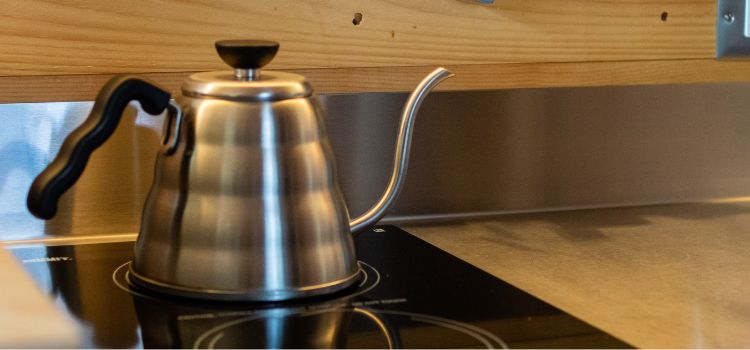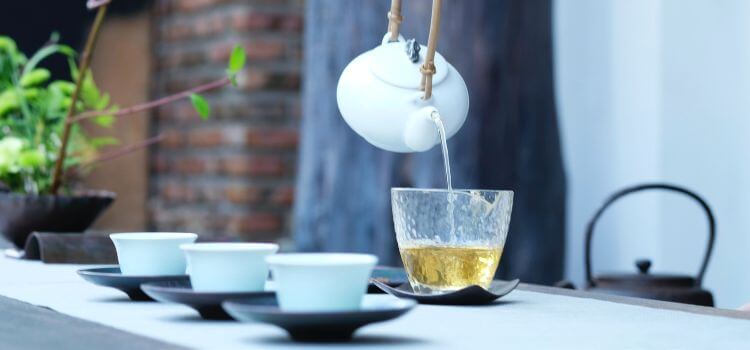As an Amazon Associate, I earn from qualifying purchases.
As an Amazon Associate, I earn from qualifying purchases
Introduction:
In a fast-paced world where convenience often takes precedence, there’s something comforting and ritualistic about preparing a cup of tea the old-fashioned way – with a classic stovetop tea kettle. If you’re new to the world of tea or simply looking to elevate your tea-making skills, you’re in the right place. In this comprehensive guide, we’ll walk you through the art of using a tea kettle on the stove to brew that perfect cup of tea that warms both body and soul.
There’s a certain charm in the whistle of a boiling kettle, the gentle hiss of steam, and the aromatic embrace of your favourite tea leaves or bags. Whether you’re a dedicated tea enthusiast or a casual tea drinker, mastering this traditional method can be a rewarding experience.
But it’s not just about the end result, that comforting cup of tea; it’s also about the journey, the process of turning simple water into a fragrant infusion. With a bit of knowledge and practise, you can ensure your tea is brewed to perfection every time.
In this guide, we’ll cover the fundamental steps, from filling your kettle with the right amount of water to selecting the appropriate heat setting on your stove. We’ll also touch on safety precautions and share some pro tips to enhance your tea-brewing skills.
Whether you’re an early riser seeking the perfect morning pick-me-up, or you prefer winding down with a soothing herbal blend in the evening, this guide will equip you with the know-how to make tea-making a cherished ritual in your daily life. So, let’s embark on this tea-sipping adventure and unlock the secrets to using a tea kettle on the stove like a seasoned tea connoisseur.

What is a tea kettle?
A tea kettle, often simply referred to as a “kettle,” is a specialized kitchen utensil designed for heating water on a stovetop or other heating sources. It typically consists of a container with a handle and a spout, designed for the purpose of boiling water quickly and efficiently.
Tea kettles are commonly made from materials such as stainless steel, aluminum, cast iron, or even copper. They come in various sizes and styles, but they all share the basic design elements of a handle for easy pouring, a spout for controlled pouring, and a lid to trap heat and steam.
One of the distinctive features of many tea kettles is a whistle mechanism. When the water inside the kettle reaches a boiling point, the whistle emits a loud, audible sound to alert you that the water is ready. This is a helpful safety feature to prevent the kettle from boiling dry and potentially causing damage.
Tea kettles are versatile and not limited to just making tea. They are also used for boiling water for coffee, instant soups, and other hot beverages or recipes that require hot water. In many cultures, the tea kettle holds a special place in the kitchen and is an essential tool for enjoying the daily ritual of tea or other hot drinks.
What is called a stove?
A stove, in the context of household appliances, is a device used for cooking and heating food. It typically consists of a flat or contoured surface on which cookware, pots, and pans are placed for cooking. Stoves come in various types and can operate using different sources of heat.
Here are some common types of stoves:
- Gas Stove: A gas stove uses natural gas or propane as a fuel source. It has burners with open flames that can be adjusted for precise temperature control. Gas stoves are popular for their responsiveness and even heat distribution.
- Electric Stove: An electric stove uses electricity to heat coiled metal burners or a smooth, glass-ceramic surface. Electric stoves are renowned for being simple to operate and maintain.
- Induction Stove: An induction stove heats the pots and pans directly, instead of heating the surface of the stove. It provides rapid heating and precise temperature control while remaining cool to the touch, making it energy-efficient and safe.
- Wood Burning Stove: A wood-burning stove is fueled by burning wood or logs. It’s often used for heating in addition to cooking and gives off a cosy, rustic ambiance. These stoves are commonly found in cabins and homes in rural areas.
- Pellet Stove: A pellet stove uses compressed wood pellets as its fuel source. It’s an efficient and environmentally friendly option, often used for heating but also capable of cooking.
- Camping Stove: A camping stove is a portable, compact stove designed for outdoor use, such as camping trips. They function on a wide range of fuels, from propane and butane to wood.
Stoves are an essential piece of cookware and play a pivotal role in the culinary process. The choice of stove type depends on factors like fuel availability, cooking preferences, and kitchen setup.

How to use a tea kettle on the stove:
Here’s a step-by-step guide on how to do it:
- Fill the Kettle with water: Begin by filling your tea kettle with the amount of cold water you need. If you want to keep the hot water inside, don’t fill it to the brim.
- Place the Kettle on the stove : Put your filled tea kettle on the stove burner. Make sure it’s centered on the burner, and the handle is facing away from the burner to avoid accidents.
- Turn On the Heat: Adjust the temperature on the stove top burner. For quicker boiling, use a medium to high heat setting. The time it takes to boil will depend on the amount of water and your stove’s power.
- Wait for Boiling: Keep an eye on the kettle as the water heats up. You’ll notice steam rising from the spout as the water gets hotter. Eventually, the water will come to a rolling boil, and you may hear a whistle sound (if your kettle has a whistle).
- Turn Off the Heat: Once the water is boiling or you’ve heard the whistle, turn off the stove burner. You can also remove the kettle from the burner if you’re concerned about residual heat.
- Pour the Hot Water: Use an oven mitt or potholder to hold the kettle’s handle (it will be hot), and carefully pour the hot water into your teapot or teacup, over your tea leaves or tea bag.
- Enjoy Your Tea: After steeping, remove the tea leaves or tea bag, add any desired sweeteners or milk, and savour your freshly brewed tea.
- Safety Precautions: Always be cautious when using a tea kettle on the stove. The kettle and handle get very hot, so use oven mitts or potholders. Keep a close watch on the kettle to prevent overboiling or overheating. Ensure the kettle is clean and free of any residue before use to maintain the tea’s flavor.
Is the tea kettle safe to use on different types of stoves?
The safety of using a tea kettle on different types of stoves depends on the type of tea kettle you have and the specific stove you’re using. Here’s a breakdown of the compatibility and safety considerations for various types of stoves:
- Gas Stove: Most traditional tea kettles are safe to use on gas stoves. Gas stoves provide an open flame, and as long as you place the kettle correctly on the burner, there should be no issue with compatibility. Just be cautious with the open flame and handle the kettle with care.
- Electric Stove: Tea kettles designed for stovetop use, such as those made of stainless steel or other heat-resistant materials, are generally safe to use on electric stoves. Just ensure that the kettle’s bottom is flat and smooth to make good contact with the heating element.
- Induction Stove: You can’t use an induction cooktop unless you have magnetic, electromagnetic field-responsive cookware. Unfortunately, not every tea kettle will work with an induction hob. To use a tea kettle on an induction stove, it must have a magnetic bottom. Many stainless steel tea kettles are compatible with induction cooktops. The bottom of the kettle should be magnetic to indicate whether or not it is induction-ready.
- Glass or Ceramic Kettles: Tea kettles made of glass or ceramic may be suitable for gas and electric stoves, but not all are safe for induction stoves. Check the manufacturer’s instructions and labeling to confirm compatibility.
- Wood-Burning Stove: Some tea kettles are specifically designed for use on wood-burning stoves. These kettles are typically made of cast iron and are meant to withstand the high heat of a wood-burning stove. Using other types of tea kettles on a wood-burning stove is not recommended.
- Pellet Stove: Pellet stoves can generate a lot of heat, so it’s crucial to use a tea kettle that can handle high temperatures. Ensure that the kettle you choose is designed for this purpose and can withstand the heat produced by a pellet stove.
Always check the manufacturer’s guidelines and recommendations for your specific tea kettle to determine its compatibility with different stove types. Using a kettle that is not designed for a particular stove type can lead to safety hazards or damage to the kettle. Additionally, exercise caution when using any kitchen appliance on a stove and follow safety precautions to prevent accidents.

Conclusion
In conclusion, mastering the art of using a tea kettle on the stove is a rewarding journey that adds a touch of tradition and charm to your tea-making experience. Whether you’re an avid tea enthusiast or a casual tea drinker, following the steps outlined in this guide can help you brew the perfect cup of tea with ease.
From filling the kettle with the right amount of water to selecting the ideal heat setting, the process is simple yet essential. Safety precautions, such as using oven mitts and keeping a watchful eye on the kettle, ensure that you enjoy your tea without any mishaps.
The beauty of using a tea kettle on the stove lies not only in the delightful cup of tea it produces but also in the ritual it creates. It’s a way to connect with the age-old tradition of tea-making and savor the flavors and aromas that accompany it.
So, whether you’re starting your day with a comforting cup of morning tea or winding down with a soothing herbal blend in the evening, this guide empowers you to make tea preparation a cherished part of your daily routine. Embrace the simplicity and satisfaction of using a tea kettle on the stove, and let the warmth of a well-brewed tea envelop you, one cup at a time.
Amazon and the Amazon logo are trademarks of Amazon.com, Inc. or its affiliates.
Leave a Reply